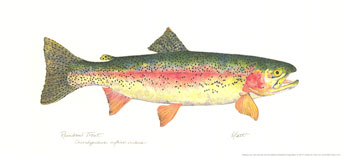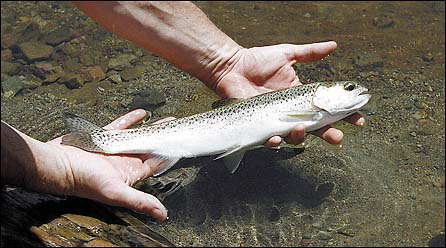Scientific Name: Oncorhynchus mykiss

Classification:
Phylum : Chordata
Class:
Actinopleygii
Order:
Salmon formes
Family:
Salmonidae
Identification: Rainbow
trout has a
salmon-like body shape. It is characterized from other lake and
stream trout by dark spots on it tail fin. The tail fin is
slightly forked, just above the anal fin which has 10-12 rays.
The rainbow trout has a dark olive-colored back which gradually shades
to a silvery white underbelly. The entire body is heavily speckled with
pink to darker red stripes that run lengthwise along the fish's sides.
Original
Distribution: Rainbow trout is native to North America in
streams and lakes west of the Rocky Mountains, ranging from Alaska into
northwestern Mexico. In general, its original distribution was
restricted to the Pacific Ocean, the coastal drainage of North America
from
Alaska to Mexico, and lakes and streams west of the continental divide
in
North America. Today, endemic populations are found in most of
the principal coastal watersheds of British Columbia, Washington, and
Oregon. Nonanadromous rainbow trout are widespread in the Fraser River
watershed, and in the Columbia River system,
except for some of the upper reaches of these systems. Rainbow
trout were indigenous to the Snake River system up to Augar Falls near
the present town of Twin Falls, Idho, and were distributed in 41
tributaries of the river below migration barriers, including streams in
northeastern Nevada. In California, populations of rainbow trout are
endemic to the Sacramento-San Joaquin system and utilize all coastal
streams with favorable environmental conditions. Further south in
the Gila drainage basin, rainbow trout are restricted to small
headwater tributaries of the Gila and San Francisco rivers in the
Mogollon Mountains of New Mexico and East Central Arizona. In the
northern part of Baja California, rainbow trout are generally
landlocked, although migration up to the Santa Bomingu River can occur
during periods of high runoff in the winter. Thus, the native
range of rainbow trout populations incorporates a very diverse array of
environmental conditions.
Current Distribution: Rainbow trout has been introduced into 47 states outside of its native territories. Other introductions include the Great Lakes region, south central Canada and portions of the Great Plain states east of the Rocky mountains, and southwestern Mexico. Populations of this species can be found in waters on all continents except Antarctica. Its range extends from the Arctic circle (Alaska, Norway, Sweden) to the Equator (Ecuador, Kenya, Uganda) in the Northern Hemisphere, and from the Equator to 55 degrees south (Argentina) in the Southern Hemisphere. Because the rainbow trout is sensitive to warm temperatures it cannot survive naturally in many of these environments and is therefore reintroduced repeatedly in order to support sport fishing.
Site
and Date of Introduction: This species of trout was originally
stocked in the Great Lakes around 1876 when they were planted in a
tributary to Lake Huron. Since then they have been widely
introduced in the Great Lake Basin and around the country. Hatchery
propagation of rainbow trout was probably first carried out in the
early 1870's by the California Acclimatization Society at a location
about 20 miles south
of San Francisco. The first recorded shipment of rainbow trout outside
their native range took place in 1874 when a small consignment
of eggs from a privately owned hatchery on a tributary of the McCloud
River in northern California was transferred to a private hatchery at
Caledonia,
New York. From 1874 to 1879 numbers of additional shipments were sent
to several locations in the US. In 1879 the US Fish Commission took
over the operation on the McCloud River, moved the hatchery a short
distance, and from 1880 to 1888 shipped out about
2.5 million eggs to various US federal hatcheries. From these
beginnings rainbow trout were subsequently distributed throughout the US
and numerous international locations.
Mode(s) of Introduction: In most cases, rainbow trout was intentionally introduced for purposes of sport fishing into new water systems by being physically transported, in adult form, and released. Those fish subsequently bred and grew in population size. In other cases, as a result of human actions, such as altering waterways or building dams, rainbow trout could move into unexplored waterways.
Reason(s) Why it has Become Established: Rainbow trout is a highly adaptable predator species that, in foreign habitats, has the ability to out compete native fish for food resources (prey) and habitat space. Rainbow trout is prized among fishermen because it puts up a fight when hooked, sometimes leaping into the air from the water's surface while on the line. This behavior may be indicative of an aggressive nature that perhaps lets it dominate the underwater community. While some other exotic trout species, such as the brown trout, have an advantage because they spawn at opposite times from the native fish, the rainbow trout must have an inherent advantage at exploiting resources given a broadly competitive niche.
Ecological
Role: Rainbow trout is a cool-to-cold water fish
species that does best in freshwater systems below 70 degrees F.
The anadronous form of the rainbow trout is called the steelhead.
It is spawned in cold tributaries and then makees its way to salt
water, or ocean ecosystems. At spawn time it migrates back up the
same tributary of its birth to lay its own eggs. Anadronous
rainbow trout spawn in the spring, generally April–June, and typically
stay for 1–4 yr in the nursery stream before migrating to the ocean.
The rainbow trout are carnivorous but they do not necessarily feed on
other fish alone; they have a wide variety of prey, including insects,
crustaceans, mollusks, and small fish. The rainbow trout's
primary predator is humans, who fish the trout for sport in practically
every aquatic environment. The rainbow trout has been observed
living at both deep depths in stream and river columns, while also
feeding close to the surface. This shows that the trout is
adaptable to varied conditions in its habitat, but it also demonstrates
a deviation from the behavior of natural populations, whose individuals
primarily occupy the base of the water column. It has been
suggested that this strange behavior is a result of 100 years of
domestication of the rainbow trout in fisheries.

Benefit(s): Rainbow
trout is a hardy fish that is well adaptable in many
freshwater environments. It primarily provides recreational
benefits to sport fishermen and anglers.
Threat(s): Rainbow trout is responsible for driving many native species into extinction or endangerment. They have eradicated frog species and threatened many native fish species in a variety of environments, such as the Californian golden trout and humpback chub in the Grand Canyon. Eliminating or diminishing other aquatic species in a given habitat can have drastic impacts on entire ecosystems, and the many trophic levels of terrestrial lifeforms that depend on aquatic systems for food.
Control
Level Diagnosis: "medium" 
Control
Method: Many methods of controlling rainbow trout
populations involve individual fish removal from the environment.
This includes specialized fishing, in other words, making laws that
restrict fisherman to only keep rainbow trout and throw back the native
species. Specialized removal has been practiced in the Grand
Canyon, Yellowstone Lake, and the Shenandoah valley where, in 1998, 147
individual fish were removed. Each of these programs has had
varied and limited success. Because rainbow trout compete
directly with other trout species, such as the brown trout, we can curb
their spread by introducing them to the sprot fishing environment at
times when other fish spawning rates are high. Most obviously,
prevention of further introduction will of course diminish the spread
of the rainbow trout.
References:
Behnke, RJ. 1979. The native trouts of the genus Salmo of
western North America. Monograph for U.S.D.A, Forest Service,
Fish and Wildlife Service, and Bureau of Land Management, Lakewood, CO.
Brannon, E.L. 2004. Population structure of
Columbia River Basin chinook salmon and steelhead trout. Reviews in Fisheries Science. 12: 99-233.
Heath, D. 2001. Genetic structure and
relationships among steelhead trout (Oncorhynchus mykiss) populations
in British Columbia. Heredity
86: 618-627.
Hershberger, W. 1992. Genetic variability in rainbow trout
populations. Aquaculture
100: 51-71.
MacCrimmon, HR. 1971. World distribution of rainbow trout
(Salmo gairdneri). J. Fish.
Res. Board Can.
Quinn, TP. 1993. Variation in life-history
patterns among New-Zealand chinook salmon
(oncorhynchus-tshawytscha). Canadian
Journal of Fisheries and Aquatic Sciences. 50: 1414-1421.